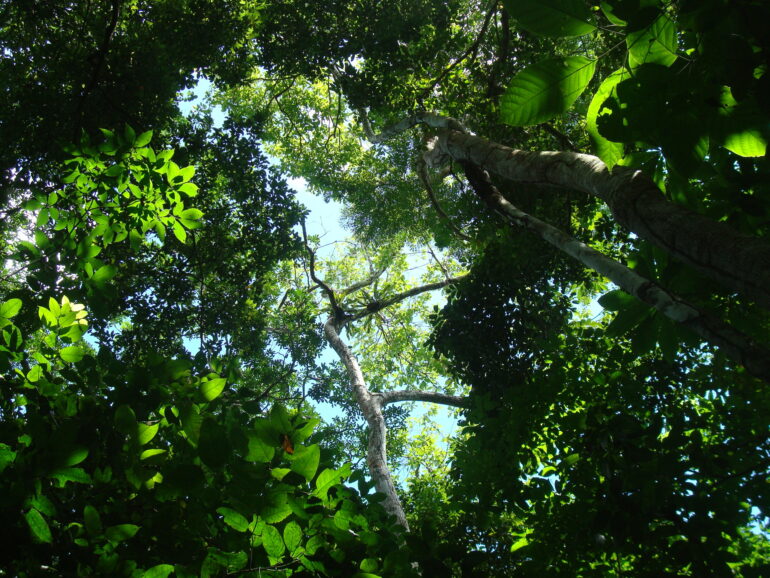Tropical forests store a third of the world’s carbon in their wood and soils. However, their future as a carbon sink has been uncertain. Scientists have long wondered whether nutrient-poor tropical soils would limit the ability of mature and recovering forests to thrive.
A study published in New Phytologist offers a hopeful response, suggesting that forests have flexible strategies that help them overcome the challenge of scarce nutrients.
“We may not have to worry about it so much,” concluded senior author Sarah Batterman, a tropical forest ecologist at Cary Institute of Ecosystem Studies. “Because of these flexible strategies, trees may be able to support a carbon sink in the future, even with nutrient constraints. Our findings support the potential of tropical reforestation and conserving intact forests as a long-term climate solution.”
An unprecedented experiment
Rising carbon dioxide levels in the atmosphere could promote the growth of tropical forests by making photosynthesis easier. However, scientists have worried that the scarcity of certain nutrients—particularly phosphorus—would limit forest growth, shrinking the potential carbon sink. Soils in the tropics are typically low in phosphorus due to weathering, and increasing rates of disturbance as well as climbing CO2 levels are expected to make soil nutrients even more scarce.
In the largest experiment of its kind, the team looked at how forests of different ages adjust two nutrient acquisition strategies used to access phosphorus: one strategy relies on an enzyme called phosphatase that is secreted by the roots of some trees, and the other leverages mycorrhizal fungi. These fungi live in soils and can partner up with trees to track down and release nutrients in the soil. Both strategies come with a significant carbon and nitrogen cost to the tree.
The scientists, led by Michelle Wong, former Cary Institute postdoc and currently an assistant professor at Yale University, wanted to learn how forests of different ages adjust their strategies for acquiring nutrients in response to changing nitrogen and phosphorus levels in the soil.
“While belowground processes are very important for ecosystem function, they are poorly understood compared to above-ground processes because they are more difficult to study,” said Wong.
Located in the lowland tropical wet forest of Panama, the field experiment covered an expansive area. Its 76 plots, spread out across 16 square kilometers of mountainous terrain, included forested areas ranging from recently abandoned pastures to mature, 600-year-old stands. While some plots were left alone, others were fertilized with nitrogen, phosphorus, or both.
For a year, the team measured the activity of phosphatase and mycorrhizal fungi in the plots, to determine the flexibility of the two strategies and whether forests invest differently in the strategies as they age and nutrient limitations change.
Solving a climate conundrum
Forests of different ages responded differently to the nutrient additions, showing that “trees are actively responding to their nutrient environment,” said Wong.

Sarah Batterman and Michelle Wong look at a microscopic image of mycorrhizal fungi. © Pamela Freeman/Cary Institute of Ecosystem Studies
In younger forests, where nitrogen tends to be the most limiting nutrient, adding phosphorus did not change phosphatase activity, but adding nitrogen did. With sufficient nitrogen, the trees could then invest in strategies to acquire more phosphorus.
In older forests, phosphatase activity increased in response to phosphorus fertilization, implying that nitrogen limitation disappears as the forest matures and then becomes phosphorus limited. Batterman identified this trend of nitrogen limitation in young forests that decreases over time in her previous work.
Phosphatase turns out to be a highly flexible nutrient acquisition strategy, increasing by half in response to nitrogen, and decreasing by half in response to phosphorus within each forest age class. Mycorrhizal colonization responses, by comparison, were less consistent and predictable.
While the results are encouraging, Batterman cautions that “We still don’t know whether the flexibility is enough to get all the nutrients forests need in the future.” Phosphatase, for example, relies on breaking down a form of phosphorus that could become more scarce in the future, so its usefulness may be limited. Still, “there may be a buffering capacity to alleviate nutrient limitation, at least for a while,” said Batterman.
Wong adds that the ability to adjust strategies may mean that the forests have “more resilience in being able to recover from land-use change or maintain productivity in an increasingly carbon-rich world.”
Informing smarter reforestation efforts
For forest managers and organizations leading reforestation efforts, the findings offer some practical advice: “We need to consider nutrient limitation when we’re reforesting,” said Batterman. “One way is to make sure we’re using a diversity of trees with different phosphorus acquisition strategies. We should also make sure we’re using trees that are adapted to the phosphorus levels at each site.”
Currently, most reforestation efforts do not implement this level of care—it’s more about getting seedlings in the ground quickly, and using whatever species are available. Nevertheless, Batterman feels optimistic about using forests as a natural climate solution.
“We can implement it immediately, it’s low cost, and it has so many co-benefits, like protecting watersheds, enhancing biodiversity, and protecting species that are important to Indigenous people. But it needs to be done correctly. We’re at a point where science can guide the process and ensure the carbon is going to be there for a long time to come.”
More information:
Michelle Y. Wong et al, Trees adjust nutrient acquisition strategies across tropical forest secondary succession, New Phytologist (2024). DOI: 10.1111/nph.19812
Provided by
Cary Institute of Ecosystem Studies
Citation:
Tropical forests adjust strategies to thrive even when soils are nutrient poor, large field experiment shows (2024, June 6)



